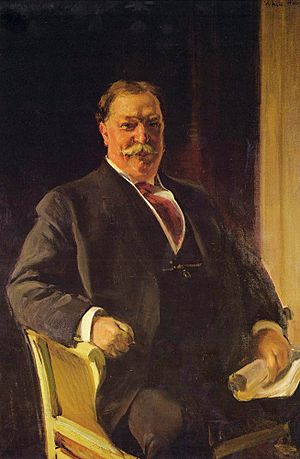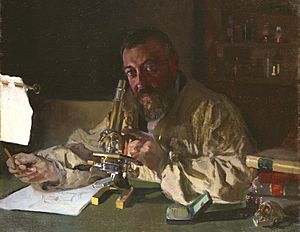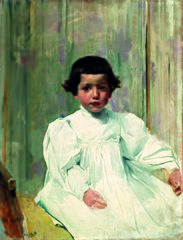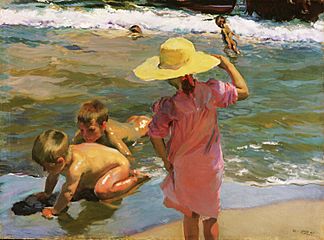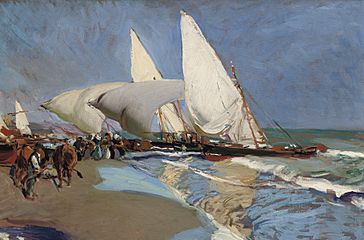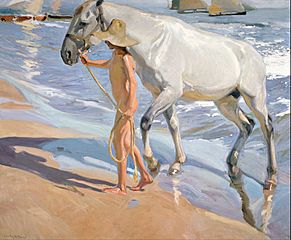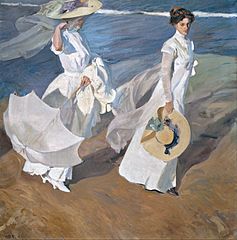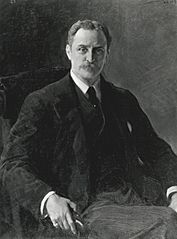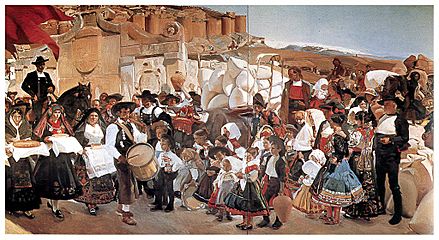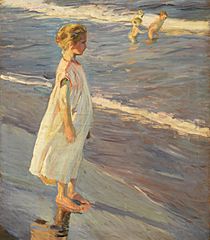Joaquín Sorolla facts for kids
Quick facts for kids
Joaquín Sorolla
|
|
|---|---|
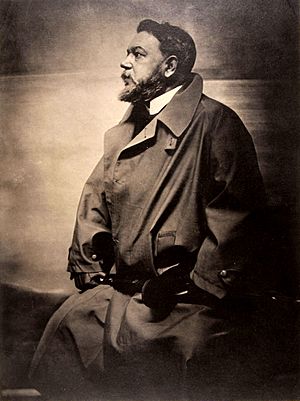
Platinum print of Sorolla by Gertrude Käsebier, c. 1908
|
|
| Born |
Joaquín Sorolla y Bastida
27 February 1863 Valencia, Spain
|
| Died | 10 August 1923 (aged 60) Cercedilla, Spain
|
| Known for | Painting, landscape art |
| Movement | Impressionism, Luminism |
Joaquín Sorolla y Bastida (Valencian: Joaquim Sorolla i Bastida, 27 February 1863 – 10 August 1923) was a famous Spanish Valencian painter. Sorolla was excellent at painting portraits, landscapes, and huge artworks about social and historical events. His most well-known paintings show people and scenery under the bright Spanish sun and sparkling water.
Contents
Biography
Early life and art studies
Joaquín Sorolla was born on 27 February 1863 in Valencia, Spain. He was the oldest child of Joaquín Sorolla, a shopkeeper, and Concepción Bastida. His sister, Concha, was born a year later. In August 1865, both children lost their parents, probably due to an illness. Their aunt and uncle, who was a locksmith, then took care of them.

Joaquín started his first art lessons at age 9 in his hometown. He then studied with teachers like Cayetano Capuz and Salustiano Asenjo. When he was eighteen, he went to Madrid and carefully studied the famous paintings in the Museo del Prado.
After his military service, at age twenty-two, Sorolla received a scholarship. This allowed him to study painting for four years in Rome, Italy. There, he was helped by Francisco Pradilla, who was the director of the Spanish Academy in Rome. A long trip to Paris in 1885 gave him his first look at modern art. Exhibitions by Jules Bastien-Lepage and Adolph von Menzel were especially important to him. Back in Rome, he studied with José Benlliure, Emilio Sala, and José Villegas Cordero.
In 1888, Sorolla returned to Valencia to marry Clotilde García del Castillo. He had first met her in 1879 while working in her father's art studio. By 1895, they had three children: Maria (born 1890), Joaquín (born 1892), and Elena (born 1895). In 1890, they moved to Madrid. For the next ten years, Sorolla mainly focused on creating large paintings about different cultures, myths, history, and everyday life. These were shown in art shows and international exhibitions in Madrid, Paris, Venice, Munich, Berlin, and Chicago.
His first big success was with Another Marguerite (1892). This painting won a gold medal at the National Exhibition in Madrid. It then won first prize at the Chicago International Exhibition, where it was bought and later given to the Washington University Museum in St. Louis, Missouri. He quickly became very famous and was seen as a leader in modern Spanish painting. His picture The Return from Fishing (1894) was very popular at the Paris Salon. The government bought it for the Musée du Luxembourg. This painting showed what his later artworks would be like.
In 1897, Sorolla painted two amazing pictures that connected art and science: Portrait of Dr. Simarro at the microscope and A Research. These paintings were shown at the National Exhibition of Fine Arts in Madrid that year, and Sorolla won the Prize of Honor. In Portrait of Dr. Simarro, he shows his friend Simarro as a scientist who shares his knowledge through research. The painting also perfectly captures the indoor setting of the laboratory. It shows the bright light from a gas lamp that mixed with the soft light from the window. These paintings are considered some of the best of their kind in the world.
The painting Sad Inheritance!
A very important moment for Sorolla's career was when he painted and showed Sad Inheritance (1899). This was a very large painting, carefully made for everyone to see. The painting showed children with disabilities bathing in the sea in Valencia, watched over by a monk. This artwork brought Sorolla his greatest official recognition. It won the Grand Prix and a medal of honor at the Universal Exhibition in Paris in 1900. It also won the medal of honor at the National Exhibition in Madrid in 1901.
Sorolla made several oil sketches for Sad Inheritance that were full of light and painted with great skill. These sketches showed his growing interest in shimmering light and how well he could handle paint. Sorolla liked these sketches so much that he gave two of them as gifts to American artists: one to John Singer Sargent and the other to William Merritt Chase. After this painting, Sorolla never again focused on such clear social issues in his art.
Becoming famous
His exhibition at the Paris Universal Exposition in 1900 won him a medal of honor. He was also named a Knight of the Legion of Honour. In the next few years, Sorolla was honored as a member of the Fine Art Academies of Paris, Lisbon, and Valencia. He was also named a "Favourite Son" of Valencia.
A special exhibition of his works – including people, landscapes, and portraits – at the Galeries Georges Petit in Paris in 1906 was even more successful than his earlier shows. This led to him being named an Officer of the Legion of Honour. The show included almost 500 artworks, from early paintings to recent sunny beach scenes, landscapes, and portraits. His ability to produce so much art amazed critics, and the show was a huge financial success.
Later large exhibitions in Germany and London were received with more calm. However, while in England in 1908, Sorolla met Archer Milton Huntington. Huntington made him a member of The Hispanic Society of America in New York City and invited him to show his work there in 1909. This exhibition featured 356 paintings, and 195 of them were sold. Sorolla spent five months in America and painted more than twenty portraits.
Sorolla's art is often shown alongside the works of his friends and fellow artists, John Singer Sargent and Anders Zorn.
Portraits
Even though formal portraits were not Sorolla's favorite type of painting, they were profitable. He also loved painting his own family. Sometimes, you can see the influence of Velázquez in his work, like in My Family (1901). This painting refers to Las Meninas and shows his wife and children in the front, with the painter himself working, reflected in a mirror far away. Other times, he seemed to want to compete with his friend John Singer Sargent, as seen in Portrait of Mrs. Ira Nelson Morris and her children (1911).
A series of portraits he painted in the United States in 1909, ordered by the Hispanic Society of America, included the Portrait of Mr. Taft, President of the United States. This portrait was painted at the White House and is now always on display at the Taft Museum of Art in Cincinnati, Ohio.
Sunlight always caught his interest, and he found his best places for portraits outdoors. So, not only did his daughter pose standing in a sunny landscape for María at La Granja (1907), but so did Spanish royalty for the Portrait of King Alfonso XIII in a Hussar's Uniform (1907). For Portrait of Mr. Louis Comfort Tiffany (1911), the American artist posed sitting at his easel in his Long Island garden, surrounded by beautiful flowers. This idea reaches its peak in My Wife and Daughters in the Garden (1910), where the idea of a traditional portrait changes into the pure joy of a painting made with thick layers of color. Here, Sorolla's love for his family and sunlight came together.
The Provinces of Spain murals
In early 1911, Sorolla visited the United States for a second time. He showed 152 new paintings at the Saint Louis Art Museum and 161 at the Art Institute of Chicago a few weeks later. Later that year, Sorolla met Archie Huntington in Paris. He signed a contract to paint a series of oil paintings about life in Spain. These 14 magnificent murals are still in the Hispanic Society of America building in Manhattan. They are 12 to 14 feet tall and a total of 227 feet long. This was the biggest project of his career and took up most of Sorolla's later life.
Huntington had imagined the work showing a history of Spain. However, the painter preferred the less specific Vision of Spain. He eventually chose to show the different regions of the Iberian Peninsula and called it The Provinces of Spain. Even though the canvases were huge, Sorolla painted all but one of them outdoors. He traveled to the specific places to paint them: Navarre, Aragon, Catalonia, Valencia, Elche, Seville, Andalusia, Extremadura, Galicia, Guipuzcoa, Castile, Leon, and Ayamonte. At each place, he painted models dressed in local costumes. Each mural celebrated the landscape and culture of its region, showing scenes with many workers and local people. By 1917, he admitted he was exhausted. He finished the last panel by July 1919.
Sorolla had a stroke in 1920 while painting a portrait in his garden in Madrid. He was paralyzed for over three years and died on 10 August 1923. He is buried in the Cementeri de Valencia, Spain.
The Sorolla Room, which holds the Provinces of Spain murals at the Hispanic Society of America, opened to the public in 1926. The room closed for changes in 2008, and the murals toured museums in Spain for the first time. The Sorolla Room reopened in 2010, and the murals are now on permanent display there.
Legacy
Sorolla had a big influence on some other Spanish painters, such as Alberto Pla y Rubio and Julio Romero de Torres. They were even called "sorollista," meaning they were influenced by Sorolla.
After his death, Sorolla's widow, Clotilde García del Castillo, gave many of his paintings to the Spanish public. These paintings became the collection now known as the Museo Sorolla. This museum is in the artist's former house in Madrid and opened in 1932.
Sorolla's work can be found in museums across Spain, Europe, and America. Many private collectors in Europe and America also own his paintings. In 1933, J. Paul Getty bought ten Impressionist beach scenes by Sorolla. Several of these are now in the J. Paul Getty Museum.
In 1960, Sorolla, el pintor de la luz (Sorolla, the painter of light), a short film, was shown at the Cannes Film Festival.
The Spanish National Dance Company honored Sorolla's The Provinces of Spain by creating a ballet called Sorolla based on the paintings.
The high-speed railway station in Valencia is named after Sorolla.
Recent exhibitions
In 2007, many of his works were shown at the Petit Palais in Paris. They were displayed alongside those of John Singer Sargent, a contemporary artist who painted in a similar Impressionist style. In 2009, there was a special exhibition of his works at the Prado in Madrid. In 2010, the exhibition traveled to the Oscar Niemeyer Museum in Curitiba, Brazil.
From 5 December 2011 to 10 March 2012, several of Sorolla's works were shown at the Queen Sofía Spanish Institute in New York. This exhibition included pieces he used during his eight years of research for Vision of Spain.
An exhibition called Sorolla & America explored Sorolla's special connection with the United States in the early 1900s. The exhibition opened at the Meadows Museum at SMU in Dallas (13 December 2013 – 19 April 2014). From there, it traveled to the San Diego Museum of Art (30 May – 26 August 2014) and then to Fundación MAPFRE in Madrid (23 September 2014 – 11 January 2015).
In 2016, the Munich Kunsthalle held a major Sorolla exhibition.
In 2019, the National Gallery, London, held a big temporary Sorolla exhibition, titled Sorolla: Spanish Master of Light.
In 2022, the Palazzo Reale in Milan held a major temporary Sorolla exhibition, titled Joaquin Sorolla: Pittore di luce (painter of light).
Gallery
-
Joaquín Sorolla García vestido de blanco, 1896. Sorolla Museum, Madrid.
The painter's son, "dressed in white". -
The Horse’s Bath, 1909. Sorolla Museum, Madrid.
-
Robert Bacon, 1909 (U.S. Department of State).
-
Castilla or La fiesta del pan, 1913. First to be completed of Vision of Spain, 14 murals at the Hispanic Society in Manhattan.
-
Niña, 1904. Museo Nacional de la Habana, Cuba.
See also
 In Spanish: Joaquín Sorolla para niños
In Spanish: Joaquín Sorolla para niños



